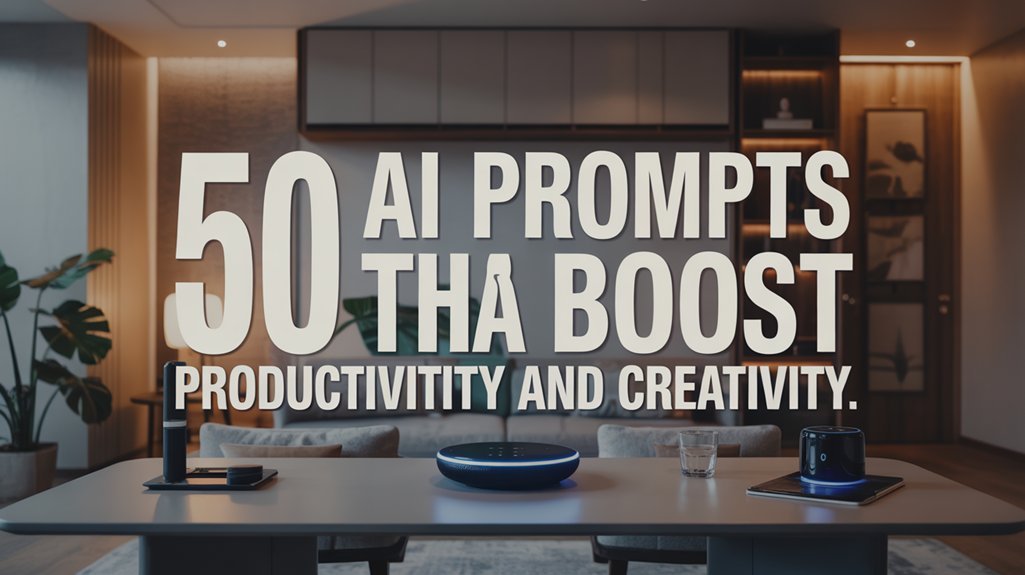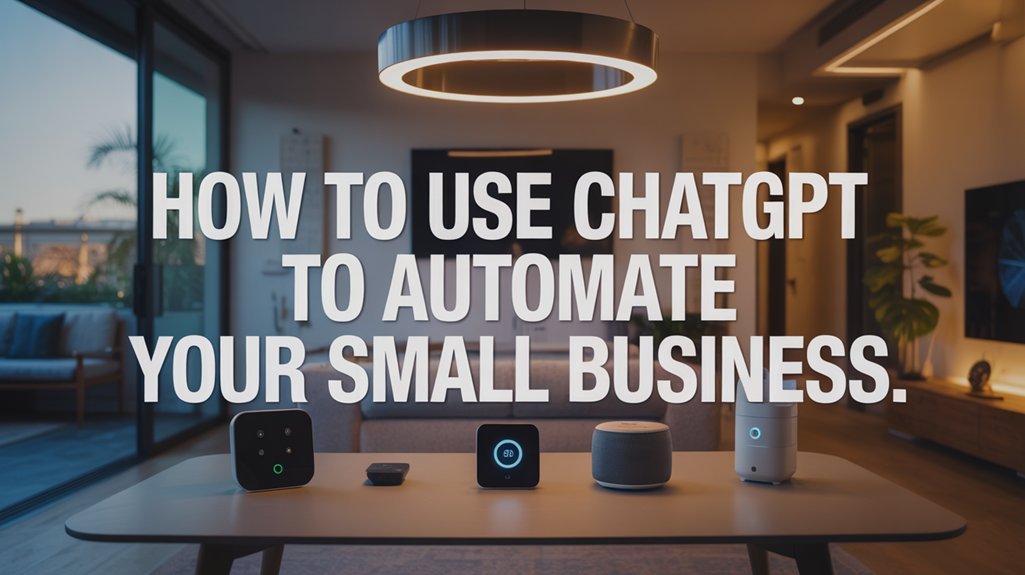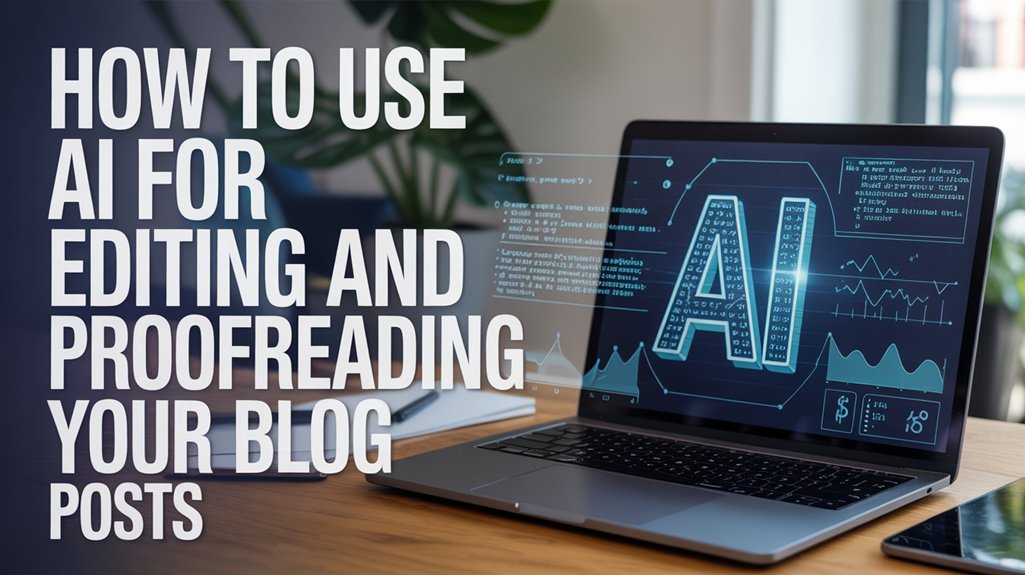You'll access productivity gains by mastering AI prompts that convert hours of work into minutes. Start by defining clear objectives and context in every prompt, then deploy them across content creation, competitive analysis, and customer sentiment tracking. Use AI to generate blog topics from market trends, extract competitor weaknesses, analyze thousands of customer feedback points, and automate research tasks that previously consumed your day. The strategic advantage compounds when you iterate these prompts into precision tools. Below, you'll discover fifty proven prompts that deliver measurable results.
Key Takeaways
- Strategic AI prompts with clear context, objectives, and constraints eliminate revision cycles and accelerate high-quality output generation.
- Automated content creation frameworks transform research and drafting from hours to minutes while maintaining SEO optimization and accuracy.
- Competitive analysis prompts identify market gaps, customer pain points, and underserved topics to exploit strategic vulnerabilities.
- Sentiment analysis prompts process thousands of social conversations to detect emerging trends and protect brand perception in real-time.
- A/B testing prompts for headlines, introductions, and outreach messages increase engagement rates and conversion effectiveness by 30%.
Understanding AI Prompts and Their Impact
When you craft a precise AI prompt, you release immediate gains in both speed and output quality. Effective prompts function as strategic directives that alter AI tools into high-performance assets for content creation and decision-making. Your command of prompt structure directly determines the value you extract from these systems.
Specificity drives results. When you define clear parameters and context, AI prompts generate outputs that align with your objectives, eliminating wasteful revision cycles. This precision accelerates your workflow while maintaining standards that reflect your vision.
Clear parameters and defined context eliminate revision cycles—precision in your prompts accelerates workflow while maintaining your standards.
The strategic advantage lies in iteration. You'll refine your approach through systematic feedback, enhancing the relevance and accuracy of each subsequent output. This disciplined method compounds your productivity gains over time.
Master effective prompts, and you release expanded creative capacity. AI becomes your instrument for exploring unconventional solutions and generating diverse perspectives that strengthen your competitive position. Advanced prompt templates provide structured frameworks that maximize your creative output while reducing the cognitive load of starting from scratch. Control the input, and you control the outcome.
Crafting Effective AI Prompts for Maximum Results
Before you type a single character into your AI interface, define your end goal with surgical precision. Vague requests generate mediocre outputs. Specify exactly what you need—format, tone, length, and constraints. Your clarity determines the AI's performance.
Structure your prompts strategically. Provide context upfront, state your objective, then include examples that demonstrate your desired outcome. This framework trains AI tools to mirror your standards and generate content that aligns with your vision.
Deploy restrictions deliberately. Set boundaries on scope, word count, and complexity level. These limitations focus the AI's processing power where it matters most.
Iterate ruthlessly. Your first prompt rarely delivers perfection. Analyze outputs, identify gaps, then refine your approach. Each iteration sharpens the AI's understanding of your requirements.
Effective prompt management ensures consistent quality across all your AI interactions, transforming sporadic success into reliable performance.
Master these fundamentals, and you'll convert prompts into precision instruments. The difference between adequate and exceptional AI-generated content lies in your strategic command of these techniques.
Generate Blog Post Ideas for Your Industry

You can alter your content strategy by leveraging AI prompts to uncover industry-specific topics that your competitors haven't covered yet.
Start by feeding AI tools your niche keywords and current market trends to generate topic clusters that align with your audience's search intent and pain points.
This approach reveals content gaps in your market while identifying trending angles that'll position your blog as a go-to resource in your industry.
Access a library of community-tested prompts to jumpstart your brainstorming process with proven frameworks that have already delivered results for other content creators.
Industry-Specific Topic Discovery
Finding the right blog topics for your industry doesn't have to be a guessing game. You can utilize AI prompts to boost your content discovery process, revealing what truly matters to your audience.
By analyzing customer feedback and market trends, you'll identify gaps your competitors miss and take advantage of emerging opportunities.
Strategic topic discovery delivers measurable results:
- Trend Analysis: Monitor industry conversations to capture 70% more visibility by targeting trending subjects before they peak
- Competitive Intelligence: Extract successful strategies from market leaders and adapt them to your unique positioning
- Content Gap Identification: Uncover underserved topics that address specific pain points in your sector
- Search Optimization: Align topics with evolving consumer interests to dominate rankings and drive organic traffic
Execute this systematically, and you'll convert content creation from reactive guesswork into a precision-driven growth engine. AI-powered content curation streamlines this entire process by automatically filtering and prioritizing the most relevant topics based on your audience's preferences and behavior patterns.
Trending Content Angles
While your competitors chase yesterday's headlines, AI-powered trend analysis positions you at the forefront of tomorrow's conversations.
You'll identify untapped market gaps and dominate emerging discussions before others recognize the opportunity. AI dissects real-time data streams, surfacing trending topics your audience craves while others rely on guesswork.
Deploy AI to generate groundbreaking ideas that merge current trends with your unique value proposition.
You'll craft content angles that command attention and establish thought leadership. This strategic advantage alters your editorial calendar from reactive to predictive.
AI-driven insights enable rapid pivots based on shifting consumer behavior.
You'll take advantage of emerging opportunities while competitors scramble to catch up. The result: sustained relevance, amplified engagement, and market dominance through consistently prescient content that resonates powerfully with your target audience.
Competitive Gap Analysis
Trend identification reveals what audiences want—competitive gap analysis shows what they're not getting.
You'll dominate by identifying the exact voids in your competitors' strategies and creating content that fills those spaces strategically.
Deploy AI to dissect competitor weaknesses and convert gaps into your competitive advantage. Generate blog posts that directly address customer pain points your rivals ignore, positioning you as the industry authority who actually solves problems.
Your competitive gap analysis framework:
- Identify competitor content weaknesses and underserved topics in your niche
- Extract customer pain points from competitor reviews, comments, and support forums
- Map gaps between audience needs and existing market solutions
- Craft marketing strategies that exploit these specific vulnerabilities
This approach doesn't just create content—it weaponizes insights.
You'll publish what matters while competitors chase trends everyone else already covers.
Identify Trending Topics Worth Exploring

You'll stay ahead of your competition by monitoring industry news sources that signal shifts in consumer behavior and market movements.
Analyzing competitor content gaps reveals untapped opportunities where you can establish authority and capture audience attention they're missing.
Tracking social media conversations provides real-time intelligence on what your target audience actively discusses, shares, and values right now.
Monitor Industry News Sources
Staying informed about industry developments separates reactive marketers from strategic ones. You'll gain competitive advantage when you utilize an AI tool to monitor industry news efficiently, altering information overload into actionable intelligence.
Deploy these tactics to maintain your edge:
- Aggregate multiple sources using AI-powered platforms that synthesize industry reports, newsletters, and social feeds into digestible summaries.
- Track competitor content systematically to identify market gaps and exploit opportunities they're missing.
- Set up keyword alerts through Google Trends and BuzzSumo to capture emerging patterns before they peak.
- Subscribe to industry-specific channels on social media and email to access insider perspectives that shape market trends.
Your ability to spot trends early determines whether you lead the conversation or follow it.
Strategic monitoring isn't passive consumption—it's your reconnaissance system for market domination.
Analyze Competitor Content Gaps
While your competitors publish content, they're simultaneously revealing what they've ignored—and that's where you'll dominate.
Deploy SEMrush or Ahrefs to expose competitor content gaps—areas where they rank but lack depth. Launch a thorough content audit of their portfolios to identify trending topics they've superficially covered or completely missed.
Monitor their social media engagement metrics ruthlessly. High engagement on specific topics signals untapped demand you can capture through unique content creation.
Scan industry forums and publications for emerging themes your competitors haven't addressed.
These gaps represent your strategic advantage. When competitors overlook valuable topics, you'll seize market share by delivering the extensive content their audiences crave.
Convert their oversights into your authority. Command attention by filling voids they don't even know exist.
Track Social Media Conversations
Social media platforms broadcast millions of real-time signals daily—conversations that reveal exactly what your target audience craves right now.
By tracking these dialogues, you'll identify trending topics worth dominating before your competitors even notice them. Deploy listening tools to capture hashtags, keywords, and discussions across Twitter, Instagram, and emerging platforms. This intelligence converts into social media graphics and campaigns that resonate immediately.
Strategic tracking requires:
- Monitoring sentiment analysis to distinguish genuine opportunities from fleeting noise and understand how audiences truly feel about topics
- Analyzing competitor engagement patterns to expose weaknesses in their content strategy you can exploit
- Identifying cross-platform conversation threads that signal sustained interest rather than temporary spikes
- Pivoting marketing initiatives rapidly based on shifting consumer demands and emerging cultural moments
Master this practice, and you'll consistently deliver content that captures attention when it matters most.
Create Comparative Analysis for Product Differentiation

When you're positioning your product in a crowded market, a comparative analysis becomes your strategic blueprint for standing out.
You'll utilize AI tools to automate data collection across price points, quality metrics, features, and customer satisfaction ratings—transforming what once took weeks into actionable intelligence within hours.
Your comparative analysis reveals precisely where your product dominates and where competitors fall short.
Mine customer feedback and market research data to identify differentiators that resonate with your target audience. These insights directly inform your marketing campaigns and product development roadmap.
Structure your analysis around hard metrics that matter: pricing advantages, feature superiority, quality benchmarks, and satisfaction scores.
AI-powered automation eliminates manual grunt work, freeing you to focus on strategic execution.
Update your comparative analysis regularly. Markets shift, consumer preferences evolve, and new competitors emerge.
Your agility in adapting to these changes separates market leaders from followers. Command your category through continuous competitive intelligence.
Draft Complete Blog Posts in Minutes
You can convert hours of blog writing into minutes by leveraging AI prompts that structure your content, generate targeted outlines, and automate research tasks simultaneously.
This approach eliminates the blank page problem while ensuring your posts maintain logical flow and SEO optimization from the start.
Structure Blog Content Effectively
Blog posts that once took hours to draft now take minutes when you utilize AI-powered structural prompts.
You'll command AI-driven prompts to architect your content with precision, eliminating guesswork and accelerating execution.
Structured prompts convert chaotic ideas into coherent narratives with clear introductions, bodies, and conclusions that drive reader engagement.
AI-generated outlines guarantee you'll cover every essential point without wasting time on reorganization.
Here's your strategic advantage:
- Deploy AI-driven frameworks that automatically organize your arguments into logical hierarchies
- Generate topic-specific templates that adapt to different content types and audience expectations
- Analyze trending keywords to position your content for maximum visibility
- Create compelling headlines that boost click-through rates before you've written a single paragraph
You'll dominate content production while competitors struggle with blank pages.
Generate Topic-Specific Outlines
Because generic outlines waste your competitive edge, AI-powered topic-specific frameworks deliver immediate structure that converts vague concepts into publication-ready blueprints. AI-generated outlines simplify content creation by identifying trending themes and subtopics your audience demands. You'll receive structured headings and bullet points that eliminate writer's block while maintaining strategic focus.
| Traditional Approach | AI-Generated Outlines |
|---|---|
| Hours organizing ideas | Minutes to structured framework |
| Generic, unfocused content | Data-driven, targeted messaging |
| Writer's block delays | Clear roadmap accelerates execution |
These frameworks improve relevance and engagement by analyzing current data and suggesting creative angles you'd otherwise miss. You'll redirect energy from organizing to refining—transforming raw concepts into authoritative content faster. Deploy AI prompts during brainstorming to dominate your niche with precision-crafted blog posts.
Automate Research and Writing
While manual research consumes hours of scrolling through articles and taking notes, AI automation changes this tedious process into an efficient operation that delivers detailed blog drafts in minutes.
You'll command superior results by deploying AI tools that automate research and content generation simultaneously. Simply input your topic, specify your tone, and watch as algorithms produce extensive drafts refined for search visibility.
Strategic advantages you'll gain:
- Accelerated production cycles: Generate complete drafts in minutes instead of hours, multiplying your content output exponentially.
- Enhanced accuracy: AI output synthesizes multiple sources instantly, eliminating research gaps and factual errors.
- Real-time collaboration: Your team edits simultaneously, compressing revision cycles and maintaining momentum.
- SEO refinement: Automatic keyword integration guarantees maximum search engine performance without manual analysis.
Transform repetitive writing tasks into strategic content direction.
Design Engaging Social Media Content
How can you change casual scrollers into engaged followers who actively interact with your brand? Deploy strategic ChatGPT prompts to generate visual content that commands attention—posts with images and videos capture 94% more views than text alone.
Utilize AI to analyze trending topics and craft timely content that resonates with your target audience's preferences. Execute A/B testing across different post formats and timing to enhance engagement rates by 30%.
Use ChatGPT prompts to develop compelling captions with clear calls-to-action, driving 20% higher click-through rates to your platforms. Alter these insights into graphic design briefs that amplify your message visually.
Apply the same AI-driven approach to email content, maintaining consistency across channels. Your data-backed strategy will double audience interaction rates, converting passive viewers into active participants.
Master these tools to dominate your market space and establish authoritative brand presence across all social touchpoints.
Write Compelling Newsletter Introductions

Your social media strategy extends naturally into email marketing, where newsletter introductions determine whether subscribers read or delete.
80% of readers abandon newsletters that fail to hook them immediately—your opening lines must earn their attention in seconds.
AI prompts modify newsletter introductions from generic greetings into engagement weapons:
- Statistical hooks: “65% of your competitors are using AI—here's how to dominate the remaining 35”
- Personal anecdotes: Share a relatable 50-word story that positions you as an authority while connecting emotionally
- Provocative questions: Challenge assumptions and force readers to reconsider their current approach
- Content previews: Deliver a crisp overview that promises concrete value and increases click-through rates by 30%
Deploy AI prompts to generate multiple introduction variations, then A/B test ruthlessly.
Your goal: capture attention within 8 seconds, set clear expectations in 50-75 words, and compel readers forward.
Master newsletter introductions, and you'll convert passive subscribers into active participants who anticipate your content.
Pitch Guest Blog Posts That Get Accepted
You'll land more guest posts when you identify publications where your expertise naturally aligns with their audience's needs and content gaps.
Start by analyzing each target blog's recent posts to craft angles that extend their existing conversations rather than repeat them.
Position your pitch around a specific problem their readers face and how your unique perspective offers a fresh solution they haven't covered.
Craft Compelling Pitch Angles
Landing a guest blog post starts with a pitch that immediately signals you've done your homework.
You'll dominate this process by using AI prompts to generate a list of tailored angles that demonstrate your strategic understanding of their platform. Your pitch must weaponize data, showcase exclusive expertise, and promise measurable value to their audience.
Deploy these power moves:
- Research-driven targeting: Analyze their top-performing posts and promote our upcoming content as a natural extension of their best material.
- Authority positioning: Lead with credentials and unique insights that position you as the definitive voice on your topic.
- Concrete value proposition: Outline specific takeaways readers will gain, not vague promises.
- Data anchoring: Reference statistics or case studies that prove your topic's urgency and relevance.
Keep it surgical: 150 words maximum.
Target Relevant Publications
A killer pitch means nothing if you're sending it to the wrong publications. Identify outlets where your expertise directly addresses their audience's needs. Analyze their content archives, noting topic gaps you can fill with authority.
Review submission guidelines meticulously—editors reject pitches that ignore their formatting requirements or word counts.
Build a target list of publications ranking them by strategic value: audience size, industry influence, and alignment with your positioning goals. Don't waste time on outlets where your message won't resonate.
Personalize your pitch for each publication by referencing specific articles they've published and explaining how your contribution enhances their existing coverage.
Include data-backed insights and writing samples that match their editorial voice. This precision separates accepted pitches from deleted ones.
Draft Collaboration Proposals for Partnerships
When you're seeking strategic partnerships, your collaboration proposal serves as the critical bridge between initial interest and committed action. You'll enhance response rates by demonstrating precise mutual benefits that align with each organization's strategic objectives. Your proposal must include concrete data points—market reach, audience demographics, revenue projections—that quantify potential impact.
Structure your collaboration proposals with these power elements:
- Clear roles and responsibilities with defined deliverables and decision-making authority for each party
- Specific timelines that create urgency and demonstrate your commitment to execution
- Previous case studies showcasing measurable outcomes from similar partnerships you've orchestrated
- Customized value propositions that directly address your partner's stated goals and market challenges
You'll accelerate approval by eliminating ambiguity. Every stakeholder should understand exactly what success looks like, who owns each initiative, and when deliverables are due.
This precision signals competence and redefines proposals into strategic imperatives.
Announce New Products With Press Releases
You can convert product announcements into media-ready press releases by using AI prompts that structure your key information into the inverted pyramid format journalists expect.
AI-generated templates help you quickly craft compelling headlines, incorporate executive quotes, and highlight essential product features while maintaining a professional tone and sector benchmarks.
This approach cuts your announcement preparation time in half while ensuring you've included all critical elements that drive media pickup and audience engagement.
Crafting Compelling Press Releases
Launching a new product demands more than innovation—it requires a strategic announcement that captures media attention and drives market buzz.
You can utilize AI to generate press releases that convert journalists into advocates and readers into customers. Your product launch deserves content that commands attention from the first word.
Master these essential elements:
- Craft headlines that drive 80% engagement by distilling your product's value into one compelling statement.
- Deploy executive quotes strategically to boost media interest by 60% and establish industry authority.
- Integrate high-quality visuals to achieve 94% higher view rates and accelerate message retention.
- Apply AP style formatting to guarantee professional presentation that journalists immediately recognize and respect.
Your press release isn't just an announcement—it's your market domination blueprint.
AI-Generated Announcement Templates
How many hours does your team waste crafting press releases from scratch when AI can generate a professional template in seconds? AI-generated announcement templates alter your new product launches into strategic opportunities. These tools greatly improve your market impact by embedding SEO optimization, compelling headlines, and data-driven phrasing directly into your announcements.
| Traditional Approach | AI-Powered Templates |
|---|---|
| 4-6 hours per release | 15 minutes per release |
| Inconsistent messaging | Brand-aligned consistency |
| Manual SEO implementation | Automatic optimization |
| Generic headlines | Data-backed compelling hooks |
Deploy these templates to dominate your market communication. You'll reclaim valuable strategic time while boosting reach. AI analyzes thousands of successful releases, extracting patterns that convert readers into customers. Your competition wastes resources on outdated processes—you'll capture attention faster and maintain unwavering brand authority.
Analyze Customer Feedback for Key Themes
Customer feedback contains untapped intelligence that can alter your business strategy—if you know how to extract it. By leveraging AI tools, you'll convert scattered comments into strategic assets that drive decisive action.
AI transforms fragmented customer voices into actionable intelligence that reshapes your competitive position and accelerates strategic decisions.
AI-powered analysis cuts through thousands of reviews in minutes, surfacing patterns that manual review would miss. You'll identify common pain points before they become crises, spot emerging preferences, and quantify sentiment across your customer base. This isn't just data collection—it's competitive intelligence that positions you ahead of market shifts.
Deploy AI to extract maximum value:
- Surface recurring themes through keyword clustering that reveals what customers actually care about
- Quantify sentiment scores to measure satisfaction levels and prioritize urgent improvements
- Segment feedback by demographics to craft targeted strategies for distinct customer groups
- Track trend evolution over time to anticipate market movements before competitors react
When you analyze customer feedback systematically, you gain the foresight to dominate your market.
Identify Customer Pain Points From Reviews
Your most valuable product insights aren't hiding in focus groups—they're sitting in plain sight within your review data. With 65% of consumers flagging quality issues in their feedback, you're already receiving strategic intelligence that drives competitive advantage.
Deploy sentiment analysis tools to process thousands of reviews simultaneously, extracting pain points that would take weeks to identify manually. When 70% of customers abandon brands after negative experiences, speed matters.
Focus on recurring themes in customer feedback—these patterns reveal systematic failures worth immediate attention. You'll discover that 74% of consumers actively seek brands addressing their concerns through tangible improvements.
The payoff is measurable: companies responding to identified pain points see 20% loyalty increases. This isn't about customer service—it's about leveraging data to dominate your market.
Change complaints into product roadmaps, and you'll convert critics into advocates while competitors remain blind to opportunities.
Conduct Sentiment Analysis on Social Media
You can utilize AI-powered sentiment analysis to decode how customers truly feel about your brand across social media platforms.
By leveraging automated tools that categorize mentions as positive, negative, or neutral, you'll gain actionable intelligence that reveals both opportunities and threats in real-time.
These insights enable you to respond strategically, refine your messaging, and address concerns before they escalate into larger reputation issues.
Understanding Social Media Sentiment
Since every tweet, comment, and post shapes public perception of your brand, mastering sentiment analysis alters raw social media data into actionable intelligence.
You'll gain consumer insights that drive strategic decisions and protect your market position.
Deploy AI-powered tools to decode emotional patterns across millions of conversations:
- Monitor real-time sentiment shifts to detect emerging crises before they escalate, protecting brand perception instantly
- Identify consumer insights that reveal what drives loyalty, with 60% of brands reporting measurably improved customer satisfaction
- Leverage positive sentiment strategically, as 79% of consumers respond to favorable social media posts
- Analyze competitor positioning through sentiment comparison, exposing market gaps you can exploit
IBM Watson and Brandwatch process thousands of posts simultaneously, reformulating emotional data into competitive advantage.
Your sentiment analysis framework becomes your early warning system and growth accelerator.
Tools for Automated Analysis
The right automated tools change sentiment monitoring from overwhelming to manageable, processing thousands of social conversations while you focus on strategy.
Platforms like Brandwatch and Hootsuite Insights deliver real-time customer insights by categorizing sentiments as positive, negative, or neutral. You'll instantly gauge audience reactions to your campaigns, products, and events.
AI-driven sentiment analysis identifies emerging issues and pain points before they escalate, enabling proactive engagement that strengthens your competitive position. The market's projected growth from $2.2 billion to $6.0 billion by 2025 signals one clear message: early adopters gain advantage.
These automated tools don't just track sentiment—they convert raw data into strategic intelligence. You'll refine customer service approaches, enhance messaging, and make decisions backed by quantifiable emotional data rather than assumptions.
Turning Insights Into Action
Raw sentiment analysis data becomes valuable only when you convert it into concrete business actions.
AI tools change social media intelligence into strategic advantages that drive measurable results. Companies leveraging sentiment analysis achieve 20% higher customer engagement by executing data-driven decisions rather than merely collecting insights.
Deploy these power moves:
- Crisis intervention protocols: Monitor sentiment shifts in real-time and deploy response teams within minutes of detecting negative trends.
- Content optimization: Amplify messaging themes that generate positive sentiment while eliminating approaches that trigger negative responses.
- Competitive positioning: Identify gaps where competitors face criticism and take advantage with superior offerings.
- Customer retention campaigns: Target accounts showing declining sentiment with personalized intervention strategies before they defect.
Your competitive edge depends on execution speed—change insights into action within hours, not weeks.
Perform SWOT Analysis on Competitors
Understanding your competitors' strategic position converts competitive intelligence into practical insights that drive market advantage.
You'll systematically evaluate each competitor's strengths—their brand equity, customer loyalty, and distinctive product features that command market share. This assessment reveals where they're formidable and where you can differentiate.
Next, identify their weaknesses: subpar customer service, limited offerings, or damaged reputation. These vulnerabilities become your attack vectors for capturing market position.
Competitor weaknesses aren't just data points—they're your strategic openings for aggressive market capture and sustained competitive advantage.
Opportunities analysis exposes gaps your competitors haven't seized—emerging technologies, shifting consumer preferences, or untapped market segments.
You'll spot where they're positioned to grow and where you can preempt their expansion.
Finally, map external threats: aggressive new entrants, regulatory changes, or economic pressures affecting their sustainability.
This intelligence enables you to anticipate their defensive moves and exploit their strategic constraints.
Deploy AI to automate this analysis continuously, altering static competitive research into fluid strategic advantage that informs every market decision you make.
Benchmark Your Engagement Metrics
You'll enhance your productivity gains by establishing clear KPIs that measure how AI prompts impact your workflow efficiency and creative output.
Compare your engagement metrics against competitor benchmarks to identify where you're outperforming the market and where gaps exist in your AI implementation strategy.
This analysis reveals specific growth opportunities, allowing you to refine your prompt engineering techniques and allocate resources to the AI applications that deliver the highest returns.
Track Key Performance Indicators
How effectively are your campaigns actually performing? Tracking key performance indicators alters guesswork into strategic dominance. You'll utilize engagement metrics to identify what drives results and eliminate what doesn't.
This intelligence enables you to make data-driven decisions that amplify your competitive advantage.
Monitor these critical metrics to maintain operational excellence:
- Click-through rates (CTR) reveal which content commands attention and drives action
- Conversion rates expose the true impact of your campaigns on bottom-line results
- Customer acquisition costs (CAC) quantify the efficiency of your marketing investments
- Return on investment (ROI) demonstrates the tangible value your strategies generate
Deploy tools like Google Analytics and social media insights to visualize performance trends.
Benchmark against market benchmarks, adapt your approach continuously, and verify your content resonates with your target audience's evolving demands.
Compare Against Competitor Data
Your internal metrics tell only half the story—competitor benchmarking reveals where you truly stand in the market. Deploy AI prompts to systematically analyze competitor data across platforms, extracting engagement metrics that expose critical performance gaps.
Command tools like Google Analytics and social media insights to quantify how your likes, shares, and comments measure against industry leaders.
Generate AI-powered competitor analysis reports that identify winning content strategies, ideal posting schedules, and high-performing audience targeting approaches. This intelligence alters vague observations into actionable strategic advantages.
Leverage AI to monitor real-time shifts in audience interaction patterns, enabling rapid tactical adjustments before competitors take advantage of emerging trends.
Regular benchmarking uncovers industry-wide consumer preferences, positioning you to dominate conversations rather than chase them. Data-driven competitor analysis isn't optional—it's your strategic weapon for market leadership.
Identify Growth Opportunities
When engagement metrics reveal gaps between your performance and industry leaders, they're simultaneously pointing toward your most valuable growth opportunities.
Artificial intelligence converts this data into strategic advantages you can exploit immediately.
Your engagement metrics expose exactly where competitors are outmaneuvering you:
- Conversion rate disparities signal messaging weaknesses or friction points in your customer journey that need immediate optimization
- Social interaction gaps reveal content formats and topics that resonate more powerfully with your target audience
- Click-through rate differences highlight competitor hooks and value propositions that command attention more effectively
- Behavioral pattern shifts expose emerging consumer preferences before they become mainstream trends
Deploy AI-powered analytics to identify these growth opportunities faster than your competition can react.
Set aggressive benchmarks, allocate resources strategically, and dominate the gaps others haven't noticed yet.
Develop Detailed Audience Profiles
Deploy surveys, social media analytics, and customer feedback to construct accurate audience profiles. Segmentation based on demographics, behaviors, and pain points enables personalized marketing that delivers up to 20% higher conversion rates.
| Data Source | Strategic Application |
|---|---|
| Surveys | Identify pain points and buying triggers |
| Social Analytics | Track engagement patterns and preferences |
| Customer Feedback | Refine messaging and product positioning |
| Behavioral Data | Predict purchase intent and timing |
Update your profiles quarterly to maintain market relevance. Static audience profiles become liabilities as consumer preferences shift. Your competitive advantage depends on understanding exactly who you're targeting and what drives their decisions. Master segmentation, and you'll dominate competitors still using broadcast marketing approaches.
Map Customer Journeys and Touchpoints
Because customers interact with your brand across multiple channels before buying, you must visualize their complete journey to eliminate friction and improve conversions.
Mapping customer journeys reveals exactly where prospects engage, hesitate, or abandon—giving you the intelligence to refine every interaction.
AI tools accelerate this process by analyzing massive datasets to identify patterns across touchpoints that would take weeks to uncover manually.
You'll pinpoint which interactions drive revenue and which create barriers to purchase.
Strategic actions to dominate customer experience:
- Deploy AI to track behavior across websites, social media, email, and customer service interactions simultaneously
- Identify pain points where customers disengage and eliminate obstacles systematically
- Prioritize touchpoints that correlate with conversions and allocate resources accordingly
- Continuously refine journeys using AI-generated insights to maintain competitive advantage
Remember: 80% of customers value experience as much as products.
Map customer journeys strategically, and you'll convert more prospects while building unshakeable loyalty.
Segment Customers for Targeted Marketing
AI-powered segmentation analyzes thousands of data points instantly, uncovering profitable customer clusters you'd never identify manually. You'll utilize customer segmentation to deliver targeted marketing that converts 14% higher than generic campaigns. AI tools process demographics, behaviors, and purchase history simultaneously, revealing patterns that drive strategic decisions.
Your segmented campaigns will capture 50% higher response rates while building 10% stronger customer loyalty. Each segment receives communications engineered for their specific needs and preferences.
| Segmentation Type | Key Metrics | Impact |
|---|---|---|
| Demographic | Age, income, location | Personalized messaging |
| Behavioral | Purchase frequency, engagement | 50% higher responses |
| Purchase History | Product preferences, spend | 14% conversion increase |
Deploy AI-driven customer segmentation to dominate your market. You'll convert raw data into revenue-generating intelligence, positioning your brand as the strategic choice for each distinct customer group. Stop guessing—start commanding market share through precision targeting.
Generate Multiple Ad Copy Variations
When you're scaling campaigns, generating multiple ad copy variations converts guessing into a systematic advantage.
Using AI to generate multiple ad copy variations saves you 50% of brainstorming time while systematically testing what drives results. You'll increase click-through rates by 30% through strategic A/B testing, and personalized messaging targeting specific pain points delivers 20% higher conversions.
AI-powered ad variations eliminate guesswork, cut brainstorming time in half, and systematically boost click-through rates by 30% through relentless testing.
Deploy AI to dominate every touchpoint:
- Email subject lines that exploit emotional triggers, boosting brand recall by 40%
- Social media ads tailored to distinct audience segments with precision messaging
- Landing page headlines refined for immediate conversion impact
- Display ad variations that adapt to real-time performance data
Address Audience Pain Points in Advertising
Why do most ads fail to convert? They ignore what keeps your audience awake at night. When you utilize customer insights to identify and address specific pain points in advertising, you'll dominate your market.
Data proves it: campaigns targeting genuine problems boost conversion rates by 30% and slash ad spend waste by 50%.
Your competitive advantage lies in precision. Use customer feedback to pinpoint exact struggles, then craft messages that position your solution as inevitable.
Over 70% of consumers reward brands that acknowledge their challenges with loyalty—that's power you can't afford to ignore.
Stop broadcasting generic features. Instead, demonstrate mastery of your audience's obstacles. When your advertising speaks directly to their frustrations, engagement soars 60%.
This isn't creativity for creativity's sake—it's strategic dominance. Deploy AI to analyze customer insights at scale, identify high-impact pain points, and generate messaging that converts skeptics into believers.
Create A/B Testing Strategies for Campaigns
Your pain-point messaging means nothing if you're guessing which version converts. A/B testing alters assumptions into actionable intelligence, giving you the power to systematically dominate your market through data-driven decision-making.
Stop guessing. Start testing. Transform assumptions into market dominance through data-driven A/B testing that systematically crushes your competition.
Execute tests that isolate single variables—subject lines, CTAs, or creative elements—to identify precisely what moves your audience. Deploy tools like Google Optimize or Optimizely to accelerate your testing cycles and capture statistically significant results.
Target a minimum of 100 conversions per variant to verify your data holds weight. Strategic A/B testing typically delivers 20-30% improvements in conversion rates. That's the difference between mediocre campaigns and market dominance.
Your AI-powered testing framework:
- Prompt AI to generate 10 variations of your highest-stakes campaign element
- Test one variable exclusively while controlling all other factors
- Analyze winning patterns across campaigns to build predictive models
- Scale proven winners immediately while iterating on underperformers
Superior conversion rates belong to those who test relentlessly.
Write Catchy Email Subject Lines
Master email subject lines to boost productivity and dominate your market. Personalized subject lines increase open rates by 47%—use recipient data strategically.
Deploy action-oriented language like “Don't miss out” or “Join us now” to create urgency and drive engagement.
Keep subject lines between 6-10 words. You'll capture attention without losing clarity. Incorporate numbers and statistics—”5 Tips to Boost Your Productivity” converts better than vague promises.
A/B test ruthlessly. Split-test different approaches to identify what moves your specific audience. Track open rates, click-throughs, and conversions.
AI prompts simplify this process: “Generate 10 subject lines for [campaign goal] targeting [audience] with urgency and personalization.”
You'll produce high-performing variants in seconds rather than hours, multiplying your campaign effectiveness while slashing time investment.
Personalize Subject Lines Using Customer Data
Generic subject lines generate mediocre results—personalization changes them into conversion machines. Customer data alters your email marketing from ignored noise into revenue-generating assets. When you utilize behavioral insights, you'll command attention and drive action.
Deploy these personalized messaging tactics to dominate inbox engagement:
- Insert customer names and purchase history to trigger 26% higher open rates while establishing immediate relevance.
- Reference browsing behavior and abandoned carts to create urgency that converts hesitation into clicks.
- Implement adaptive subject lines that automatically adjust based on customer segments, delivering up to 50% higher click-through rates.
- A/B test personalized variations against generic alternatives to identify which data points enhance your specific audience's response.
Remember: 72% of consumers engage exclusively with personalized messaging. Your competitors using generic templates are hemorrhaging opportunities.
Utilize customer data strategically, and you'll capture market share while they wonder why their campaigns underperform. Execution separates winners from observers.
Build Urgency in Limited-Time Offers
Why do customers abandon carts at the final moment? They're waiting for a compelling reason to commit.
You'll convert hesitation into action by engineering urgency into your limited-time offers.
Deploy countdown timers on landing pages—they've driven conversion increases up to 300% by creating visual pressure. Pair them with scarcity messaging: “Only 10 items left in stock” can boost conversions by 20%. You're not manipulating; you're clarifying stakes.
Leverage time-sensitive language that demands immediate response: “Offer ends in 24 hours” triggers decisive action. Amplify this with social proof—display how many customers have already purchased to generate FOMO that compels urgency.
Structure exclusive deals for early movers: “First 50 customers receive an additional 20% off.” This strategy rewards quick decision-making while maximizing revenue velocity.
These tactics don't just boost productivity in your sales funnel—they establish your authority by demonstrating you understand behavioral economics and deliver results that matter.
Optimize Email Layouts for Engagement
You'll boost engagement by structuring your email layouts around three core elements that convert readers into action-takers.
Start with strategic design principles that utilize white space and visual hierarchy. Then implement mobile-first templates that adapt smoothly across devices.
Position your call-to-action buttons where eye-tracking data shows maximum visibility—typically above the fold and aligned with your content's natural flow.
Strategic Layout Design Principles
When your email layout competes for attention in a crowded inbox, strategic design principles become your most powerful conversion tool.
Master layout design by implementing proven techniques that drive user engagement and conversions.
- Deploy single-column architecture to boost user engagement by 30% while maintaining laser-focused reader attention.
- Position CTAs prominently to capture 28% higher click-through rates through strategic button placement and compelling copy.
- Ensure mobile-responsive design to dominate the 50%+ mobile user segment and enhance your reach across all devices.
- Establish visual hierarchy through calculated font variations, increasing information retention by 73% and guiding reader behavior.
Limit images to 20% of content to avoid spam filters and accelerate load times.
These principles change emails from ignored messages into conversion machines.
Mobile-First Responsive Templates
While your perfectly crafted email message might shine on desktop screens, it'll fall flat if mobile users can't read it—and they represent over 50% of your audience.
Mobile-first responsive templates automatically adjust layout elements for ideal readability across devices, delivering a 15% boost in click-through rates.
You'll command better results: brands leveraging responsive templates generate 36% higher revenue per email than competitors using static designs.
These templates eliminate extensive coding requirements, accelerating your campaign deployment while maintaining visual impact.
The strategic advantage is quantifiable—mobile-first design drives 20% higher conversion rates because your audience demands smooth navigation on their devices.
Implement responsive templates to enhance engagement and dominate your market through superior mobile optimization.
Call-to-Action Button Placement
Your CTA button placement determines whether subscribers engage or exit—position it above the fold and you'll capture 20% more clicks from readers who won't scroll.
Strategic call-to-action positioning directly impacts email performance. Utilize these proven tactics:
- Deploy contrasting colors that make your CTA impossible to ignore against your email background
- Write commanding copy like “Get Started Now” or “Claim Your Discount” to drive 35% higher conversions than weak alternatives
- Execute A/B testing on multiple placements and designs to identify what triggers action in your specific audience
- Position secondary CTAs at the email's end, after delivering value that primes subscribers to convert
Master these placement principles and you'll convert passive readers into active participants.
Your email performance metrics will reflect the power of strategic CTA optimization.
Provide Personalized Product Recommendations
How can you convert casual browsers into committed buyers? Deploy AI-driven personalized recommendations that enhance your conversion rates by up to 300%. By analyzing browsing patterns and purchase history, you'll deliver precisely what customers want—when they want it.
| Metric | Impact |
|---|---|
| Conversion Rates | Up to 300% increase |
| Average Order Value | 10-30% boost |
| Customer Retention | 60% improvement |
| Recommendation Accuracy | Continuously refined |
| Brand Loyalty | Noticeably strengthened |
Machine learning algorithms alter every interaction into actionable intelligence, refining suggestions with each click. You'll capture 10-30% higher average order values as customers add AI-recommended items to their carts. The strategic advantage? Customer retention soars by 60% when you consistently deliver relevant experiences.
Your recommendation engine evolves automatically, becoming sharper and more profitable over time. Stop guessing what customers want—let AI decode their preferences and position your products as irresistible solutions.
Tailor Content Based on Reader Interests
Because readers abandon generic content within seconds, AI-powered personalization changes casual visitors into engaged audiences.
You'll utilize data analytics to decode user preferences and deploy targeted content that commands attention. Your personalized content strategy delivers measurable dominance: 26% higher open rates and conversion improvements reaching 200%.
Deploy AI to segment audiences strategically:
- Behavioral tracking: Monitor click patterns, scroll depth, and content consumption habits to refine your targeting precision.
- Dynamic content delivery: Serve customized blog recommendations, headlines, and calls-to-action that align with individual user journeys.
- Demographic segmentation: Filter content based on industry, role, location, and experience level to enhance relevance.
- Predictive algorithms: Anticipate user needs before they search, positioning your content as the authoritative solution.
You're not just creating content—you're architecting experiences that drive 30% longer site engagement and 14% higher click-through rates.
Master personalized content delivery, and you'll capture the 80% of consumers who demand tailored experiences before committing loyalty.
Create Customized Deals From Purchase History
You can utilize AI to analyze your customers' past purchase patterns and convert that data into targeted promotional strategies that drive conversions.
By examining buying frequencies, product combinations, and seasonal trends, you'll identify the specific deals each customer segment values most.
This strategic approach enables you to create personalized offers that resonate with individual preferences, increasing both engagement rates and revenue.
Analyzing Past Purchase Patterns
When customers browse your online store and complete purchases, they leave behind valuable data trails that reveal their preferences, buying habits, and pain points. Mining these purchase patterns alters raw transaction data into strategic intelligence that drives revenue growth.
Deploy AI-powered analysis to access competitive advantages:
- Segment customers by behavior – Group buyers based on frequency, average order value, and product categories to target each segment with laser precision.
- Identify cross-sell opportunities – Detect complementary products frequently purchased together to create irresistible bundle offers.
- Predict seasonal demand spikes – Forecast inventory needs by analyzing historical buying cycles and emerging trends.
- Craft personalized deals – Generate offers that align with individual purchase histories, boosting customer engagement by 29%.
This data-driven approach increases conversion rates by 20% while building lasting customer loyalty through strategic personalization.
Tailoring Promotional Offer Strategies
Convert your purchase history data into revenue-generating promotional campaigns that speak directly to each customer's demonstrated interests.
You'll increase conversions by up to 30% when your promotional offers align with established buying patterns. AI-powered segmentation changes raw data into targeted strategies that deliver $44 ROI per marketing dollar spent.
Deploy personalized deals that boost retention rates by 20% while commanding 10-15% higher spending per transaction.
Your customers respond to recognition—tailored promotions prove you understand their preferences and value their business.
Leverage analytics to cut campaign creation time in half without sacrificing impact.
Strategic segmentation enables you to deploy precise offers that resonate with specific customer cohorts.
This data-driven approach eliminates guesswork, enhances your marketing efficiency, and changes customer preferences into predictable revenue streams.
Generate Dynamic Email Content
Every marketer knows the challenge of creating email content that resonates with diverse audience segments while maintaining efficiency at scale.
AI alters this bottleneck into your competitive advantage. You'll utilize AI-generated content to produce personalized email content within seconds, freeing you to focus on strategic execution rather than drafting from scratch.
Deploy AI to dominate your email campaigns through these capabilities:
- Subject line enhancement — Analyze past performance metrics to craft headlines that boost engagement by up to 50%
- Audience segmentation — Generate targeted messages based on customer behaviors and preferences, achieving 26% higher open rates
- Dynamic content creation — Automate personalized variations at scale without sacrificing quality or authenticity
- Performance-driven refinement — Employ campaign analytics to continuously improve content for maximum response rates
You'll eliminate inefficiencies while multiplying results.
AI doesn't replace your strategic vision—it amplifies your ability to execute it with precision and speed across every customer touchpoint.
Facilitate Team Brainstorming Sessions
Brainstorming sessions stall when teams cycle through the same perspectives and hit creative walls. You can break this pattern by deploying AI-generated insights that challenge conventional thinking and reveal new strategic directions.
Structured prompts convert unfocused discussions into targeted ideation. They keep your team aligned on objectives while exploring diverse solutions. AI automates session documentation, freeing your members to concentrate entirely on generating breakthrough concepts.
| Traditional Approach | AI-Enhanced Method |
|---|---|
| Manual note-taking disrupts flow | Automated documentation captures everything |
| Limited perspectives dominate | AI introduces external viewpoints |
| Past learnings often forgotten | Instant analysis of previous outcomes |
| Discussions drift off-topic | Structured prompts maintain focus |
Use AI insights as catalysts, not replacements. Your team builds on machine-generated suggestions to develop proprietary solutions competitors can't replicate. This approach accelerates ideation velocity while maintaining strategic control over outcomes. You'll move from idea generation to implementation faster than teams relying solely on traditional brainstorming methods.
Identify Emerging Industry Trends
How do you spot the next market disruption before your competitors? AI-powered trend forecasting alters raw data into strategic advantages.
You'll utilize machine learning algorithms that detect patterns in consumer behaviors across millions of touchpoints, revealing shifts your rivals haven't noticed yet.
Real-time data analysis positions you to act proactively rather than scramble reactively. Your AI tools continuously monitor market signals, processing historical data to predict what's coming next with increasing accuracy.
AI-powered forecasting transforms market intelligence from reactive guesswork into proactive strategy, giving you the competitive edge before opportunities vanish.
Deploy these AI-driven strategies to dominate your market:
- Sentiment analysis scanning social platforms to identify emerging topics before they reach mainstream attention
- Pattern recognition algorithms uncovering subtle changes in purchasing behaviors and preferences
- Predictive models that forecast industry shifts based on historical trend data
- Regular model updates with current datasets to maintain forecasting precision
You'll craft tailored marketing strategies that align with emerging demands, securing first-mover advantage while competitors remain behind the curve.
Analyze Competitor Strategies for Market Shifts
You can utilize AI to systematically identify competitor marketing tactics by analyzing their campaign patterns, messaging strategies, and customer engagement approaches across multiple channels.
This intelligence enables you to predict industry trend shifts before they fully materialize, giving you a strategic window to adapt your positioning and offerings.
Identify Competitor Marketing Tactics
Understanding what drives your competitors' marketing success positions you to outmaneuver them in rapidly shifting markets.
You'll gain decisive advantages by systematically dissecting their competitor marketing tactics across multiple fronts. Deploy tools like SEMrush to expose which keywords fuel their traffic, then exploit gaps they've overlooked.
Analyze their content marketing patterns to identify weaknesses in their messaging architecture. Monitor social media engagement metrics to benchmark performance and uncover creative approaches worth adapting.
Execute these tactical moves:
- Conduct SWOT analyses to pinpoint exploitable weaknesses and untapped market opportunities
- Track email campaigns to decode their retention strategies and subject line formulas
- Map advertising channels to understand their budget allocation and reach priorities
- Document engagement techniques to accelerate your own audience-building initiatives
Transform competitive intelligence into market dominance.
Predict Industry Trend Shifts
Market dominance requires more than tracking your competitors' current moves—you must anticipate their next ones before they execute.
Deploy SWOT analysis to dissect competitor strategies, exposing vulnerabilities you can exploit and strengths you must counter. Monitor their product launches and campaigns to decode emerging consumer preferences before they become mainstream demands.
Leverage social media analytics and customer feedback data to understand how rivals adapt to market trends in real-time. Use this intelligence to position yourself ahead of shifts, not behind them.
Regular industry benchmarking alters competitors' historical patterns into your predictive advantage.
When you forecast market movements through competitor analysis, you don't react to change—you orchestrate it. This strategic foresight converts market intelligence into commanding positioning that competitors struggle to match.
Forecast Future Marketing Trends
While traditional forecasting methods rely on historical data and gut instinct, AI-powered predictive analytics now delivers precise insights into tomorrow's consumer behaviors before they fully materialize.
You'll gain decisive competitive advantages through AI-driven analysis that converts market speculation into strategic certainty.
Your marketing arsenal expands dramatically when you utilize these capabilities:
Predictive analytics transforms your marketing from reactive guesswork into proactive market domination through data-driven precision.
- Real-time behavioral tracking enables you to pivot campaigns instantly as consumer patterns shift, eliminating wasted budget on outdated strategies.
- Enhanced personalization drives conversion rates up to 30% by delivering precisely calibrated content that resonates with individual preferences.
- Automated campaign management simplifies execution across channels, freeing your team to focus on high-impact strategic decisions.
- Sustainability alignment identifies eco-conscious opportunities that capture the growing demographic demanding responsible consumption.
Deploy predictive analytics to anticipate market shifts rather than react to them.
You'll position your brand ahead of trends while competitors scramble to catch up, securing market dominance through data-driven foresight.
Define Key Performance Indicators
Success in any business initiative hinges on measurement—specifically, on tracking the right metrics that illuminate progress toward your strategic objectives. Key Performance Indicators (KPIs) are measurable values that quantify how effectively you're achieving organizational goals. You'll enhance their impact by ensuring each KPI meets SMART criteria: Specific, Measurable, Achievable, Relevant, and Time-bound.
Structure your KPIs hierarchically. Deploy strategic KPIs for company-wide objectives, operational KPIs for departmental performance, and individual KPIs for team accountability. Focus on metrics that drive decisions: customer acquisition cost, lifetime value, ROI, and conversion rates deliver actionable intelligence about your competitive position.
Your KPIs aren't static. Market fluctuations shift, and your measurement framework must evolve accordingly. Review and recalibrate quarterly, eliminating metrics that no longer serve strategic priorities.
When you define the right KPIs, you create a performance dashboard that changes data into dominance—giving you the competitive edge that separates market leaders from followers.
Analyze Campaign Performance Data
You'll enhance your campaign's impact by tracking key metrics like conversion rates, engagement levels, and ROI to understand what's working and what isn't.
When you identify performance gaps—areas where results fall short of targets—you can pinpoint exactly which elements need refinement.
Use this data to make strategic adjustments that shift resources toward high-performing tactics and eliminate what's draining your budget without delivering results.
Key Metrics to Track
Campaign performance data converts guesswork into strategic decision-making when you track the right metrics.
You'll dominate your market by monitoring click-through rates—averaging 2.6% across sectors—to assess ad content effectiveness immediately. Conversion rates between 1-5% reveal your campaign's true power to change prospects into customers, while ROI metrics expose financial performance, with elite campaigns delivering $3 for every dollar invested.
Master these essential indicators:
- Engagement metrics: Track likes, shares, and comments to identify content that drives 20% higher retention rates
- Bounce rates: Monitor the 40-60% threshold to enhance landing page performance
- CTR benchmarks: Compare against sector norms to refine targeting
- ROI multipliers: Calculate exact returns to scale winning campaigns and eliminate underperformers
Your data-driven decisions compound competitive advantages.
Identify Performance Gaps
When your campaigns generate thousands of data points weekly, performance gaps hide in plain sight—costing you revenue while competitors surge ahead. You need systematic campaign analysis to expose underperforming elements before they drain your budget.
Deploy AI tools to dissect your performance metrics instantly. These systems identify exactly where conversion rates plateau, click-throughs stall, and ROI deteriorates. You'll pinpoint weaknesses your manual reviews miss—transforming raw data into actionable intelligence.
Benchmark your results against competitor campaigns to contextualize your standing. This competitive intelligence reveals untapped opportunities and strategic vulnerabilities.
Master data-driven decision-making by letting AI surface patterns across conversion funnels, audience segments, and channel performance. You'll eliminate guesswork, redirect resources strategically, and reclaim market dominance.
Every insight becomes ammunition for optimization.
Data-Driven Strategy Adjustments
Raw performance metrics mean nothing until you convert them into strategic pivots that amplify winning campaigns and kill resource drains.
You'll reshape campaign performance data into competitive advantage by executing data-driven strategy adjustments that separate market leaders from followers.
Your power move involves these critical actions:
- Segment audiences by demographics to weaponize messaging that resonates with high-value customer groups and eliminates wasted spend on underperformers.
- Deploy A/B testing ruthlessly across campaign elements to extract practical insights that fuel immediate strategy adjustments.
- Leverage Google Analytics and social media insights to identify which campaigns deliver maximum ROI and warrant scaling.
- Monitor KPIs relentlessly—click-through rates, conversion rates, and return on ad spend—to make real-time pivots that crush competition.
Data-driven strategy adjustments aren't optional—they're your pathway to market dominance.
Generate Customer Engagement Insights
Understanding customer engagement patterns converts scattered data into strategic advantages that drive measurable results. You'll utilize AI-driven surveys to capture authentic feedback while achieving 25% higher response rates than traditional methods. Personalized content delivers a commanding 14% increase in click-through rates, reshaping passive audiences into active participants.
| Strategy | Impact | Advantage |
|---|---|---|
| Personalized Content | 14% CTR increase | Superior engagement |
| Targeted Email Campaigns | 30% engagement boost | Precise audience reach |
| Customer Segmentation | 20% conversion lift | Enhanced campaign ROI |
Deploy AI sentiment analysis across social channels to decode customer emotions and refine your communication approach. Segment your audience based on engagement data—you'll reveal a 20% conversion rate improvement through precisely tailored offers. Targeted email campaigns reflecting genuine customer interests outperform generic approaches by 30%, establishing your market dominance through strategic intelligence rather than guesswork.
Analyze Brand Perception in the Market
How accurately does your target market perceive your brand's value proposition? AI-powered analysis alters brand perception monitoring into a strategic advantage.
Deploy sentiment analysis tools to dissect consumer feedback across social channels, extracting actionable intelligence that drives market success.
Leverage AI prompts to systematically evaluate your brand's standing:
- Deploy real-time sentiment tracking across platforms to identify perception shifts before they escalate into reputation crises
- Generate competitive positioning maps that reveal gaps between your brand perception and competitors' market standing
- Extract pattern recognition from customer reviews to pinpoint specific attributes driving positive or negative sentiment
- Create predictive models that forecast brand perception trends based on historical consumer feedback data
Command this intelligence to recalibrate messaging, enhance product positioning, and neutralize negative narratives swiftly.
AI eliminates guesswork, replacing it with data-driven precision that amplifies your brand's market dominance.
Execute these strategies to maintain supremacy in your sector.
Develop Messaging Strategies for Target Audiences
You'll achieve higher engagement rates when you craft messages that directly address your audience's specific needs and motivations.
Start by using AI prompts to generate multiple messaging variations tailored to different audience segments, then systematically test each version to identify which language and tone drive the strongest response.
This data-driven approach lets you refine your communication strategy based on what actually converts, not assumptions.
Audience-Centric Message Creation
When you speak directly to what your audience cares about, your messages cut through the noise and drive real engagement.
Audience-centric messaging alters generic communication into powerful tools that command attention and compel action. By leveraging customer personas, you'll craft personalized messages that speak directly to specific pain points, driving response rates up to 500% higher than broad approaches.
Deploy these strategic tactics to dominate your market:
- Test relentlessly through A/B testing to enhance every message element, achieving 26% higher open rates
- Harness storytelling that forges emotional connections and builds unshakeable brand loyalty
- Analyze metrics continuously to refine your approach and maintain competitive advantage
- Target precisely using demographic and psychographic data to elevate impact
Master audience-centric messaging, and you'll control the conversation while competitors struggle with ineffective mass communication.
Testing Message Effectiveness
Testing message effectiveness changes guesswork into strategic dominance. You'll utilize A/B testing to compare messaging strategies head-to-head, extracting data that reveals which approaches drive superior engagement and conversions.
Deploy personalization tactics—addressing customers by name and referencing their interaction history—to capture 29% higher email open rates and 41% increased click-throughs.
Analyze customer feedback systematically to identify language patterns and themes that resonate with your target audience. You'll refine your messaging strategies based on concrete sentiment data, not assumptions.
Leverage AI tools to dissect competitor messaging and establish performance benchmarks. This intelligence positions you to differentiate your communication and align precisely with audience expectations.
Each test cycle sharpens your competitive edge, converting messaging from art into science. Your data-driven approach eliminates weak performers and amplifies what works.
Identify Unique Selling Propositions
Every successful business needs a clear answer to one critical question: why should customers choose you over the competition? Your unique selling proposition defines that answer, altering vague advantages into sharp competitive weapons.
Your USP transforms nebulous benefits into precision-targeted competitive advantages that compel customers to choose you over every alternative in your market.
Strategic market research reveals the attributes that command attention and drive decisions—64% of consumers demand this clarity before they'll commit their dollars.
Deploy AI to extract and refine your USP through systematic analysis:
- Analyze competitor positioning to identify gaps and opportunities in your market landscape
- Mine customer feedback for recurring pain points your solution uniquely addresses
- Test message variations across segments to determine which propositions generate maximum response
- Quantify your differentiation with specific metrics that prove superiority over alternatives
Brands wielding strong USPs capture 20-30% higher customer engagement than their unfocused competitors.
That's the difference between dominating your market and fading into obscurity. Your USP isn't marketing fluff—it's your strategic foundation for conquering market share.
Generate High-Traffic Keyword Lists
Your USP means nothing if your target audience can't find you. Dominate search rankings by deploying AI to generate high-traffic keyword lists that drive qualified traffic directly to your content.
Command tools like Google Keyword Planner and Ahrefs to extract monthly search volumes and competition metrics—then utilize AI prompts to synthesize this data into actionable keyword strategies.
Focus your efforts on long-tail keywords that convert. These specific phrases capture buyers ready to act, not just browse. AI excels at identifying these high-intent opportunities your competitors overlook.
Deploy prompts that analyze competitor keyword usage systematically. Uncover gaps in their strategies and exploit them ruthlessly. Your search engine optimization success depends on strategic keyword deployment, not guesswork.
Update your keyword lists quarterly. Consumer search behaviors shift constantly—stagnant lists guarantee declining visibility.
Use AI to monitor emerging trends and adjust your content strategy before competitors recognize the opportunity. Power belongs to those who anticipate market movements.
Suggest Long-Tail Keywords for Products
You'll capture more qualified buyers by targeting long-tail keywords that match exactly how customers search for your products.
AI tools can analyze search patterns and generate highly specific keyword variations that your competitors overlook, giving you a strategic advantage in less crowded markets.
Understanding Long-Tail Keyword Benefits
While short-tail keywords might seem attractive for their high search volumes, long-tail keywords deliver the targeted traffic that actually converts into sales.
You'll capture customers at the precise moment they're ready to buy, not just browse.
Strategic advantages you'll command:
- Drive targeted traffic with three-plus word phrases that account for 70% of all searches, connecting you directly with high-intent buyers
- Dominate lower-competition spaces where you'll rank higher without fighting industry giants for visibility
- Improve conversion rates by matching specific customer intent, altering clicks into revenue-generating transactions
- Slash your advertising costs through reduced CPC rates, stretching your marketing budget further while maintaining quality leads
Deploy long-tail keywords in your product descriptions and metadata to enhance SEO impact and revenue potential.
AI-Generated Keyword Research Methods
Modern AI keyword research tools change how you discover profitable long-tail opportunities that traditional methods miss entirely.
These AI-generated keyword research methods analyze millions of search patterns, uncovering three-plus-word phrases your competitors overlook. You'll identify niche-specific long-tail keywords with minimal competition and maximum conversion potential, giving you strategic advantages in crowded markets.
Deploy AI algorithms to decode user intent and predict emerging search trends before they peak. Your SEO strategy gains precision when you target phrases like “ergonomic wireless keyboard for small hands” instead of generic terms.
Integrate these keywords into product descriptions and content immediately—you'll capture qualified traffic ready to convert.
Update your keyword portfolio monthly with AI insights. You'll dominate niche segments while competitors waste resources chasing broad, impossible-to-rank terms.
Execute this approach systematically for measurable traffic growth.
Optimizing Product Page Visibility
Because product pages compete against thousands of similar listings, strategic long-tail keywords become your primary weapon for capturing purchase-ready customers.
These three-or-more-word phrases target specific searches, delivering qualified buyers directly to your offerings. With 70% of web searches using long-tail keywords, you'll dominate less competitive niches while broader keywords drain your competitors' resources.
Implement this product page optimization strategy:
- Embed keywords in titles and meta tags to claim prime search engine real estate and boost SEO rankings
- Weave long-tail phrases into product descriptions naturally, speaking directly to customer pain points
- Target buyer-intent keywords like “best wireless headphones for running” rather than generic “headphones”
- Monitor conversion data to identify which long-tail keywords generate actual sales, not just traffic
You'll capture higher-converting traffic while competitors fight over saturated keywords.
Write SEO-Friendly Meta Descriptions
Meta descriptions serve as your content's elevator pitch in search results, directly influencing whether users click through to your site or scroll past it.
Craft SEO-friendly meta descriptions within 150-160 characters to enhance visibility and control your search presence.
Integrate targeted keywords strategically—they'll appear bolded in search results, commanding attention and establishing immediate relevance.
You're not just describing content; you're capturing market share through precision language.
Deploy action-oriented verbs that compel clicks. “Discover,” “Master,” “Transform”—these power words drive engagement and boost productivity and creativity in your conversion funnel.
Include your brand name to promote recognition and establish authority.
Monitor performance analytics relentlessly. Your meta descriptions aren't static—they're strategic assets requiring continuous optimization.
Test variations, track click-through rates, and refine based on data. High-performing descriptions directly correlate with improved rankings and increased organic traffic.
You're competing for attention; make every character count toward dominating your niche.
Conduct Comprehensive SEO Audits
Your meta descriptions attract clicks, but without a solid technical foundation, even the most compelling snippets won't save a site riddled with structural problems.
Thorough SEO audits reveal the weaknesses undermining your rankings and traffic potential.
Deploy AI to systematically dissect your website's architecture and performance:
- Analyze page load speed and mobile responsiveness to eliminate friction points that hemorrhage visitors and tank your user experience metrics
- Evaluate on-page elements including title tags, headers, and keyword refinement to guarantee every page targets search intent with precision
- Audit your backlink profile to identify toxic links sabotaging your domain authority while uncovering high-value link-building opportunities
- Leverage tools like Google Analytics and SEMrush to extract actionable intelligence on traffic patterns, behavior flows, and ranking fluctuations
Execute SEO audits every six months minimum.
Algorithm updates don't wait for your convenience, and competitors actively exploit your blind spots.
Audit relentlessly, enhance ruthlessly, dominate consistently.
Monitor Website Performance Metrics
While technical audits expose structural flaws, real-time performance metrics reveal how your site actually performs under live conditions—and the data doesn't lie.
You're losing 7% of conversions for every second your pages lag. That's revenue vanishing while you wait.
Deploy Google Analytics to track website performance metrics that matter: bounce rate, session duration, and pages per session.
These KPIs expose exactly where user engagement breaks down. Monitor organic search traffic to validate your SEO targeting—if keywords aren't driving qualified visitors, pivot immediately.
Leverage A/B testing to eliminate guesswork. Test call-to-action buttons, landing page designs, and conversion paths.
The winning variants reveal user preferences you can exploit across your entire site.
Your competitors are making data-driven decisions while you're guessing.
Page load time, traffic patterns, and engagement metrics aren't vanity numbers—they're intelligence assets that separate market leaders from followers. Track them ruthlessly.
Generate Infographic Ideas From Data
Data sitting idle in spreadsheets represents wasted persuasion power—convert it into infographics and watch information retention jump 65%.
You'll utilize AI to identify compelling patterns within your data, then generate visual concepts that command attention and drive action.
Strategic infographic approaches that amplify your influence:
- Social domination: Deploy data-driven infographics that get shared 3x more than standard content, extending your reach exponentially.
- Interactive elements: Boost user engagement by 30% through clickable charts and animated statistics that convert passive viewers into active participants.
- Visual-text fusion: Improve comprehension by 83% by strategically combining graphics with minimal, high-impact text.
- Conversion acceleration: Deploy infographics in campaigns to increase click-through rates by 40%, converting insights into measurable results.
Feed your raw data into AI prompts requesting visualization concepts, comparison frameworks, and storytelling angles.
You'll extract maximum value from every dataset while positioning yourself as the authority who communicates complexity with clarity.
Create How-To Guide Visuals
When your audience encounters unclear instructions, they abandon tasks at a 70% rate—but AI-generated visuals convert confusion into completion.
Deploy AI tools to alter complex processes into compelling how-to guides that command attention and drive action. Provide precise instructions and context to generate step-by-step illustrations that align with your brand's authority. These visuals eliminate ambiguity, accelerating comprehension and task completion.
Leverage AI analytics to decode audience preferences, then craft targeted how-to guides that resonate with your demographic's specific needs. Generate multiple design variations rapidly, executing A/B tests to identify which styles enhance engagement and conversions.
Optimize your guides across every platform—social media, websites, print—by directing AI to adjust dimensions and formats automatically. This multi-channel approach amplifies your reach while maintaining visual consistency.
The strategic advantage: AI compresses weeks of design work into hours, freeing your resources for high-level decision-making while your audience gains clarity, capability, and results.
Develop Graphic Design Briefs for Campaigns
Campaign failures trace back to one critical weakness: vague design briefs that leave your creative team guessing instead of executing. You need a graphic design brief that commands results, not confusion.
Your brief must define objectives with surgical precision. Specify your target audience demographics, psychographics, and pain points. Declare your visual style—minimalist, bold, corporate, disruptive—whatever aligns with your brand dominance.
Surgical precision in brief objectives eliminates guesswork—define your audience, declare your visual style, dominate your market.
Structure your brief to eliminate ambiguity:
- Deliverables with specs: List exact dimensions, formats, and quantities for each asset (Instagram stories, LinkedIn banners, billboard specs)
- Competitive benchmarks: Include 3-5 competitor campaigns showing what to emulate or obliterate
- Budget and timeline: Define spending limits and milestone deadlines upfront
- Revision protocol: Establish clear feedback rounds with decision-maker authority
Your graphic design brief becomes your strategic weapon. Deploy it with clarity, watch your creative team deliver campaigns that capture market share.
Blend Cross-Disciplinary Ideas for Innovation
Your breakthrough innovation won't emerge from staying in your lane—it'll explode from the collision of disparate disciplines.
Cross-disciplinary collaboration amplifies creativity by 25%, directly translating to successful market launches. The smartphone's dominance proves this principle—telecommunications merged with computing and design to reshape global commerce.
Deploy AI prompts that force interdisciplinary synthesis. Command it to combine frameworks from unrelated fields: “Merge neuroscience principles with supply chain optimization” or “Apply game theory to customer retention strategies.”
This strategic approach mirrors innovation ecosystems that boost readiness by 50%.
Your varied experiences become weapons for original ideation. Individuals drawing from diverse domains generate breakthrough concepts that specialists miss.
Structure your AI queries to exploit this advantage—request solutions that blend psychology with data science, or architectural thinking with software development.
Cultivate cross-functional teams. Companies leveraging diverse perspectives dominate their markets through relentless innovation.
Your competitive edge lies in orchestrating these intellectual collisions systematically.
Generate Actionable Solutions for Specific Challenges
Because generic advice wastes resources, precision-engineered AI prompts convert vague challenges into executable action plans. You'll slash decision-making time by deploying structured prompts that force specificity, altering abstract problems into concrete steps.
These AI prompts generate actionable solutions by analyzing data patterns your team might overlook, delivering intelligence that drives measurable results.
AI-powered prompts detect critical patterns buried in your data, transforming overlooked insights into concrete, results-driven strategies.
Strategic implementation looks like this:
- Deploy iterative refinement cycles where you feed AI-generated solutions back into subsequent prompts, creating increasingly sophisticated strategies that adapt to your evolving challenges.
- Structure prompts with constraints and success metrics to extract solutions aligned with your actual resource capacity and timeline requirements.
- Leverage cross-functional data integration so AI synthesizes insights from marketing, operations, and finance simultaneously.
- Automate repetitive problem-solving workflows to redirect your cognitive resources toward high-impact strategic initiatives.
This approach doesn't just boost productivity—it compounds your competitive advantage. You're building systematic problem-solving infrastructure while competitors remain mired in manual brainstorming sessions.
Frequently Asked Questions
What Are Some Really Good AI Prompts?
You'll optimize results by mastering AI writing techniques that command specificity—state exactly what you want, include relevant context, and define your success metrics.
Deploy AI brainstorming strategies that utilize examples and iterative refinement to dominate your niche.
For superior AI content generation, you'll structure prompts with clear objectives, targeted tone specifications, and format requirements.
Don't ask—instruct. Your competitive advantage lies in treating AI as your strategic weapon, not a conversation partner.
How to Use AI to Boost Productivity?
You'll release exponential productivity gains by deploying AI strategically across your operations.
Start with workflow automation to eliminate repetitive tasks—achieving up to 50% faster project completion.
Utilize AI for task management and prioritization, letting algorithms identify high-impact activities.
Implement time optimization tools that intelligently schedule your calendar, reclaiming 15% of your work hours.
The data proves it: leaders who master AI-driven systems don't just work faster—they dominate their markets while competitors struggle with manual processes.
How Can AI Increase Creativity?
AI increases your creativity by deploying creative brainstorming techniques that generate hundreds of concepts in minutes, giving you decisive competitive advantage.
You'll utilize AI-generated inspiration to break through mental barriers and explore unconventional solutions others miss.
Utilize AI in collaborative art projects to iterate rapidly, refine bold ideas, and dominate your creative space.
You're not just creating—you're strategically amplifying your creative power to outpace competitors and seize market opportunities faster than ever before.
What Are Some Good AI Art Prompts?
A picture's worth a thousand words—make yours count. You'll dominate AI art generation by crafting precise prompts for abstract landscapes (“ethereal mountain ranges with crystalline structures”), character designs (“cyberpunk warrior with bioluminescent armor”), and surreal portraits (“face merged with clockwork mechanisms”).
Specify styles like “oil painting” or “3D render,” add atmospheric descriptors like “haunting” or “majestic,” and iterate relentlessly. Each refinement amplifies your creative control, converting vague ideas into commanding visual assets that capture attention and establish your artistic authority.
Conclusion
You've now got a Swiss Army knife of AI prompts ready to change your workflow. Don't let these tools gather dust—deploy them strategically across your projects today. Start with three prompts that address your biggest bottlenecks, measure the results, then expand from there. You'll cut through creative blocks, accelerate decision-making, and deliver higher-quality work in less time. Your productivity breakthrough isn't coming tomorrow—it's available right now.









